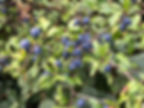Blackthorn - Prunus spinosa
- The Foraging Course Company
- Mar 30, 2022
- 2 min read
Updated: Jul 30, 2025

Edible plant - novice Season - flowers early spring, autumn fruit Common names blackthorn, sloe, sloe bush
Scientific name meaning: Literally meaning plum tree, Prunus is a Latin word. Spinosa is from the Latin spina, meaning thorn or spine
Habitat  Blackthorn can be found in hedgerows, woodlands, parks and gardens. It is a native of Britain, Europe and North Asia. |
Overall structure  A low-growing tree reaching around 7m, with thin branches and dark bark. |
Leaves  Leaves are oval shaped, wrinkled and serrated. The leaves broaden slightly towards the tip. |
Stem/trunk  The bark is smooth and very dark coloured. Long thorns emerge from the branches. |
Flower  Flowers are creamy white, with five petals and visible reproductive parts. They are found clustered along the thorns and bloom in March to April. |
Fruit  The flowers are followed in Autumn by small dark purple fruits containing a single stone. The skin of the fruit often has a blueish cast. |
Use as a food The fruit is often used to make gin liqueurs. It is too astringent and bitter to eat raw. Cooked, the fruit is used to make jams, jellies, syrups, ketchups and chutneys.
The flowers are also edible in moderation and have a mild almond flavour Hazards The leaves and seeds contain cyanogenic glycosides and hydrogen cyanide. The seeds/stones, leaves, barks, stems and twigs should not be consumed.
Use in herbal medicine and medicine Has been used to treat flatulence, diarrhoea, muscle spasms and fevers.
If you are suffering from any ailment or need medical advice, please see your General Practitioner Other uses The traditional wood for making Irish shillelaghs, it is used to make other walking sticks. Different coloured dyes can be made from several parts of the tree. Its thorns make it excellent stock hedging. Importance to other species Provides a valuable nectar source for pollinators, and abundant food source for birds. The leaves provide a food source for the caterpillars of the lackey, magpie, common emerald, small eggar, swallow-tailed and yellow-tailed moths, as well as black and brown hairstreak butterflies.
Several birds nest in blackthorn hedges and feed off these caterpillars and other insects living on the blackthorn.
Always stay safe when foraging. You need to be 100% sure of your identification, 100% sure that your foraged item is edible, and 100% sure that you are not allergic to it (it is good practice to always try a small amount of any new food you are consuming). If in doubt, leave it out!






